COMP 3000 2011 Report: Funtoo Linux
Background
Download
| Official Download Page | http://www.funtoo.org/wiki/Download |
| Github Profile | https://github.com/Funtoo |
Funtoo Linux is a distribution that aims to improve the core technologies of Gentoo. It is a source-based distribution which features a git-based Portage tree, GUID (Globally unique identifier) partition tables (GPT) boot support, enhanced network configuration and native UTF-8 support. <ref>Funtoo Linux. Retrieved on October 16, 2011 from http://distrowatch.com/table.php?distribution=funtoo</ref> It is targeted at experienced Linux users and is extremely configurable, sometimes even referred to as a meta-distribution. It is also very fast. <ref>About Gentoo. (September 17, 2007). Retrieved on October 16, 2011 from http://www.gentoo.org/main/en/about.xml</ref>
Funtoo's core system, the stage3 tarball, is 110 megabytes.
One of the features of Funtoo Linux is that it allows GUID partition tables. This partitioning scheme supports partitions greater than 2TiB, which is the size limit of the standard MBR (Master Boot Record) partitioning scheme.
This is essential for systems using RAID (redundant array of independent disks) logical volumes, as it is easy to exceed the partition size limit imposed by the MBR.
<ref>GUID Booting Guide. (March 4, 2011). Retrieved on October 16, 2011 from http://www.funtoo.org/wiki/GUID_Booting_Guide</ref>
History
Funtoo's history is closely tied to that of Gentoo. Daniel Robbins was the project creator,
chief architect and project leader of the Gentoo development team until April 26, 2004,
where he had to leave because of personal issues.
<ref>CDs and t-shirts, Gentoo mailing list. (April 24, 2004). Retrieved on October 16, 2011 http://article.gmane.org/gmane.linux.gentoo.nfp/65</ref>
Before leaving, Mr. Robbins created a non-profit foundation, Gentoo Technologies, which would
hold all of the Gentoo copyrights.
<ref> Founder of Gentoo Linux, Daniel Robbins, Resigns as Chief Architect. LBN Industry News Desk. (April 27, 2004). Retrieved on October 16, 2011 from http://linux.sys-con.com/node/44614</ref>
After working at Microsoft for two years, Mr. Robbins rejoins the Gentoo development team. In 2007, the Gentoo Foundation looses its status due
to negligence. Daniel Robbins submitted a proposal to fix this problem but it was refused due to his prolonged absence. Mr. Robbins created
Funtoo Linux because of this.
<ref>Goal of Funtoo. (October, 2008). Retrieved on October 16, 2011 from http://blog.funtoo.org/2008/10/goal-of-funtoo.html</ref>
Virtualization Setup
Using Virtual Box 4.1.2. I am sharing my virtual hard drive with two hosts, each running different virtual machines. I do this because my desktop machine is faster at compiling.
Hosts
| Gentoo Linux x64 w/ linux-3.0.4-gentoo kernel (Laptop) |
| Intel Core 2 Duo CPU P8400 @ 2.26GHz |
| Allocating 2 cores, 1024Mb RAM to VM. |
| Windows 7 Professional x64 (Desktop) |
| Intel Core 2 Quad CPU Q6700 @ 4.0GHz |
| Allocating 4 cores, 2048Mb RAM to VM. |
Guest
- Enabled IO APIC.
- Enabled PAE/NX.
- Enabled VT-x/AMD-V.
- Using VHD format, 20GB.
Installation
Installing Funtoo Linux is a manual process. It does not have an automated installer because it is not needed. You can actually install Funtoo Linux while being booted in you current OS, provided you have the tools (ex. fdisk, git).
Overview
- Boot in an arbitrary Linux system (Live CD or otherwise).
- Prepare the disk where Funtoo Linux will be installed.
- Install the Funtoo stage tarball of your choice.
- Chroot into the new Funtoo Linux system.
- Pull the Portage tree repository.
- Customize the system configuration.
- Install a kernel.
- Install a bootloader.
- Setup users and boot-time services.
- Reboot.
Taken from the official install guide. <ref>Funtoo Linux Installation. (October 8, 2011). Retrieved on October 17, 2011 from http://www.funtoo.org/wiki/Funtoo_Linux_Installation</ref>
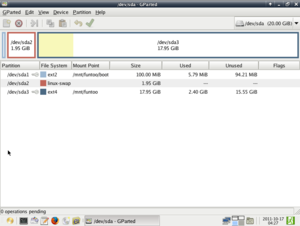
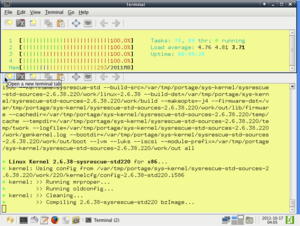
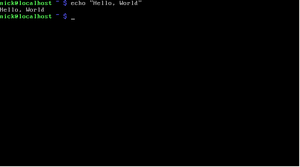
To perform a Funtoo install, you must use an existing Linux system or a live CD. Unlike Gentoo, Funtoo Linux does not have a dedicated live CD. That is because its Metro build tool does not support live CD builds yet. Instead, it recommends the use of SystemRescueCD, a Linux system rescue disk, because it comes with all the software you need for the installation. For my installation, I used SystemRescueCD. I would have used my Linux machine but I could not find a way to use fdisk with VHD's.
After booting in the Linux system of your choice, you must first prepare the disk that Funtoo will be installed on. This is the preferred way of partitioning your disk for a Linux system. That said, I had to use MBR partitioning because VirtualBox's BIOS does not support booting from GPT disks. <ref>Huge Hard Disk support >2TB discussion. Technologov. (October 11, 2009). Retrieved on October 17, 2011 from https://forums.virtualbox.org/viewtopic.php?f=4&t=23279</ref> No big deal: I am not planning on using a > 2TiB disk for my virtual machine.
I installed from a stage3 tarball, because I am not crazy enough to start from stage1. Stage3 is the recommended one to use anyway. To install from a stage3 tarball, you first download the stage tarball and then you extract its contents in the Funtoo Linux's root partition. Now that all the core Funtoo Linux programs are installed, you switch to the Funtoo Linux system by chrooting into it.
Then, using git, you pull the Portage tree from Github. Funtoo Linux uses a git-based portage system, which allows smaller manifest file sizes because it leverages Git's file integrity checking mechanisms. In the rsync-based system, you would also need a change log. With Git, commit messages are used instead. <ref>Funtoo Linux FAQ, What is a mini-manifest. (August 29, 2011). Retrieved on October 17, 2011 from http://www.funtoo.org/wiki/Funtoo_Linux_FAQ#What_is_mini-manifest.3F</ref>
After tweaking a few config files, I had to get a kernel. I opted to use a kernel that would be generated by genkernel because I was not sure what kind of configuration was needed for a virtual machine. During compilation, I got some strange gcc error. Since I was not sure what the problem was, I decided to hop on the Funtoo irc channel and see if somebody could help me. Here's the chat log (Surjikal is me):
Turns out the 256MB of RAM I allocated to the VM was insufficient to compile a kernel. But what really surprised me it was that the chief architect (drobbins) helped me out! Compilation took about 3 hours, but its not too bad since the process is automated.
After compiling the kernel, you must setup the bootloader. This involves installing the GRUB package, modifying a config file and running a GRUB config generator script. This step is much easier and much more automated than on Gentoo, where you would have to edit the GRUB configuration directly. Setting up users was a breeze. There's nothing Funtoo Linux specific about that step.
That's it! A reboot is all that is needed.
Basic Operation
Note: This section may be easier to understand after reading the software packaging section.
Funtoo Linux gives you the power to customize almost any aspect of your distribution. This is why after installation, you are only presented with a simple bash prompt. While I had no problem with the command line, I needed some kind of window manager in order to stay sane. This means I had to install an X server.
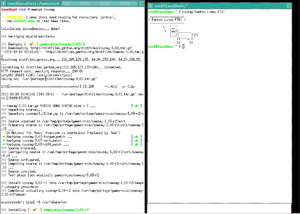
Installing an X Server
First, I must configure my use flags since I want to keep my installation as lightweight as possible. I removed the gnome, kde and qt4 use flags in my make.conf file, as only wanted GTK+ support.
Then, I added configuration entries in my make.conf that specified which video card and input devices my computer had. <ref name="vbox-guest">VirtualBox Guest. (December 14, 2011). Retrieved on December 14, 2011 from http://en.gentoo-wiki.com/wiki/Virtualbox_Guest</ref>
Then, I had to install the virtualbox input and video drivers:
Finally, I installed X:
To check if my X server was working properly, I installed twm (window manager) and xterm (terminal emulator):
Then, I started the X server:
After I have successfully installed xorg-server, I removed twm and xterm as I only needed them for testing:
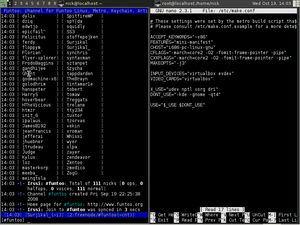
Installing Awesome
Awesome is a fast tiling window manager that has true multihead support and can be extended via its Lua interface. <ref>Awesome window manager home page. Retrieved on December 14, 2011 from http://awesome.naquadah.org/</ref>
Installing awesome is simple in Funtoo Linux:
Customization
The default awesome configuration is good enough for most people, but here are some of the modifications I did to mine:
- This will populate awesome's menu with your installed applications: https://github.com/terceiro/awesome-freedesktop
- I also stole some parts of these config files: http://git.sysphere.org/awesome-configs/
Compiling and installing a kernel
It is very easy to compile and install a Linux kernel in Funtoo Linux. Indeed, as shown later, there are many variations to choose from. I decided to install the Gentoo kernel, because it is stable and I am familiar with it.
First, I had to retrieve the source code of the kernel:
emerge -av gentoo-sources
The source was unpacked to /usr/src/linux-3.1.1-gentoo/. I went to that directory and I started configuring the kernel:
cd /usr/src/linux-3.1.1-gentoo make menuconfig
I had to customize my kernel configuration so that it could run properly in virtual box as a guest. Here's what had to be enabled/disabled: <ref name="vbox-guest" />
Processor type and features --->
[*] Tickless System (Dynamic Ticks)
[ ] High Resolution Timer Support
[X] Symmetric multi-processing support (keep this enabled for multiple cores, too!)
Subarchitecture Type (PC-compatible) --->
[ ] Machine Check / overheating reporting
[X] SMT (Hyperthreading) scheduler support (This too, for i7's)
Power management and ACPI options --->
[*] Power Management support
[ ] Suspend to RAM and standby
[ ] Hibernation (aka 'suspend to disk')
[*] ACPI (Advanced Configuration and Power Interface) Support --->
Device Drivers --->
< > ATA/ATAPI/MFM/RLL support
<*> Serial ATA and Parallel ATA drivers
<*> AHCI SATA Support
[*] ATA SFF support
<*> Intel ESB, ICH, PIIX3, PIIX4 PATA/SATA support
[*] Network device support --->
[*] Ethernet (10 or 100Mbit) --->
[*] EISA, VLB, PCI and on board controllers
<M> AMD PCnet32 PCI support
[*] Ethernet (1000 Mbit) --->
<M> Intel(R) PRO/1000 Gigabit Ethernet support
[ ] Ethernet (10000 Mbit) --->
Input device support --->
[*] Mice --->
<*> PS/2 mouse
Graphics support --->
<*> Direct Rendering Manager (XFree86 4.1.0 and higher DRI support) --->
< > all options can be empty
<M> Sound card support --->
<M> Advanced Linux Sound Architecture --->
[*] PCI sound Devices --->
<M> Intel/SiS/nVidia/AMD/ALi AC97 Controller
After I was done configuring, I compiled the kernel:
make && make modules_install
Then, I moved the kernel to my boot partition, and renamed it to something more descriptive. The compiled kernel is located at ./arch/x86/boot/bzImage.
mv arch/x86/boot/bzImage /boot/linux-3.1.1-gentoo
Furthermore, I added the following lines to my boot configuration file (/etc/boot.conf):
"Funtoo Linux (compiled kernel)" {
kernel linux-3.1.1-gentoo
}
Finally, I generated the boot-loader (grub) configuration:
boot-update
Usage Evaluation
Funtoo Linux is an extremely capable source-based distribution. The process of compiling applications is painless, but it is lengthy. However, for big applications such as firefox, you can set the binary use flag to simply download and install the binary, instead of compiling from source.
The portage tree contains a lot of packages, and most of them are up to date. If a package is unavailable you can most likely find it through an overlays. For example, you can install the Gnome3 package from the Gnome overlay.
Funtoo Linux is extremely customizable. It is the reason why I chose this distribution: I was tired of some distribution maker deciding what is best for me. That said, Funtoo Linux can be a bit frustrating when it comes to errors. Since you are dealing with the source directly, it can be hard to get everything configured properly. Also, updating your system can be quite a chore and it can take several days to complete the process. Also, if a library is updated, and the ABI or API changes, then everything that depends on this library must be recompiled. To be fair, these problems usually happens when you waiting too long (>6 months) before updating. And of course, all the tools to help you update your system are available through portage.
Software Packaging
What packaging format and utilities are used?
There are no packages or archives like .deb or .rpm files in Funtoo Linux. Instead, a package is a directory which contains an ebuild script, a manifest file, patch files and configuration files. Funtoo Linux allows you to customize which parts of the package you want to compile via use flags.
Ebuild Scripts
An ebuild or ebuild script is a bash script which runs in a special environment, and describe how to download, compile, configure and install a package. The ebuild usually downloads a distfile, which is a source tarball, but can also pull the source from a repository. <ref>Writing Ebuilds. (28 June, 2011). Retrieved on November 11, 2011 from http://en.gentoo-wiki.com/wiki/Writing_Ebuilds</ref>
Manifest File
The manifest file is used to determine the integrity of source tarballs (called distfiles). In Gentoo, it is also used to check all files in the package. This is not required in Funtoo Linux since git takes care of that. The manifest files are still needed because the source tarballs are not contained in the git repository and so they must be checked after the ebuild downloads them.
To illustrate the difference in package management between Gentoo and Funtoo, here's a comparison of the Manifest file for the cowsay package:
Gentoo
AUX cowsay-3.03-mech.patch 490 RMD160 bc2318e9832108a39728e92806578566618fad8e SHA1 cec033ce530daa01736a841f351144f3ca5aea3d ...
AUX cowsay-3.03-tongue.patch 358 RMD160 9de33eec59e44fd2a375bca1419313f856bade7f SHA1 4cb24d5ea35df531c1e8ad2d000d643e41e97964 ...
AUX cowsay-3.03-utf8.patch 454 RMD160 00ea66c1561dd6ec2a31156c49f7f8d067b7b119 SHA1 f8eca4fa5dd4c7d404b215ca98601715042a7b62 ...
DIST cowsay-3.03.tar.gz 15189 RMD160 f26b9ffe3d5551ee8049979c628bbe198817044a SHA1 cc65a9b13295c87df94a58caa8a9176ce5ec4a27 ...
EBUILD cowsay-3.03-r2.ebuild 1245 RMD160 14bce76715480958f0dfa33d1c95e7033965c4d1 SHA1 7c73d1ef3dc0166174acfb28749a896ce8832272 ...
MISC ChangeLog 4354 RMD160 5681d5b0ee3d5c8a343451258269797fb9140793 SHA1 0378422a1656d493aad0e31aad66c42cf0a10e71 ...
MISC metadata.xml 158 RMD160 cbd9984bb6b426c8c9cee5022fe0a26261612fea SHA1 be5251fa1dacef5c41b74761bb1c8c54fb633b9e ...
Funtoo
DIST cowsay-3.03.tar.gz 15189 RMD160 f26b9ffe3d5551ee8049979c628bbe198817044a SHA1 cc65a9b13295c87df94a58caa8a9176ce5ec4a27 ...
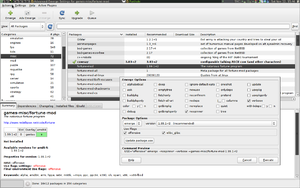
Portage
Portage is the software management tool of Funtoo Linux. <ref>Portage. (September 23, 2011). Retrieved on December 18, 2011 from http://www.funtoo.org/wiki/Portage</ref> It is composed of two programs: Ebuild and Emerge. Ebuild is the tool which runs ebuild scripts. Emerge is the tool that keeps track of installed packages, resolves dependencies and provides the main portage interface.
Porthole is a GUI front end to portage. It is very useful if you are a first time Funtoo Linux or Gentoo user and works great as a package and use flag browser.
The portage tree is the set of all packages available on the system. It is a a directory tree, usually rooted at /usr/portage.
Overlays
An overlay is a set of ebuilds which can be merged with the main portage tree of your distribution. <ref>Gentoo Overlays: Users' Guide. (July 25, 2011). Retrieved on November 11, 2011 from http://www.gentoo.org/proj/en/overlays/userguide.xml</ref> The Funtoo Linux tree is composed of the Gentoo overlay, the Funtoo overlay, and the slashbeast, multimedia, tarsius, golodhrim third party overlays. <ref>Funtoo Linux. (November 8, 2011). Retrieved on December 18, 2011 from http://www.funtoo.org/wiki/Funtoo_Linux</ref>
Use Flags
Use flags are used to specify which component of a package you want/don't want to compile. Doing this cuts down compilation by a significant amount because it greatly reduces the number of dependencies pulled in. Use flags can be set globally or they can be package specific. Global use flags are specified in /etc/make.conf.
For example, if I want to disable the Gnome and KDE components of packages, globally, this is how I would modify my make.conf file:
DONT_USE="-kde -gnome"
OTHER_USE="freetype laptop"
USE="$OTHER_USE $DONT_USE"
Other Tools
Equery is a collection of modules for querying the state of Funtoo Linux packages, files and USE flags.<ref>Equery man page</ref> It is not bundled with the distribution and it is part of the gentoolkit package. This program uses the /var/db/pkg directory which contains the state of portage. <ref>Gentoo Files and Directories. (March 2, 2011). Retrieved on November 13, 2011 from http://www.gentoo.org/doc/en/handbook/handbook-x86.xml?part=3&chap=1</ref>
How can you use these utilities to get a list of installed packages?
Equery can be used to get a list of installed packages:
equery list "*"
Alternatively, you can list the directories in /var/db/pkg.
find /var/db/pkg -maxdepth 2 -type d
To see which packages were emerged explicitly:
cat /var/lib/portage/world
How do you add and remove packages?
Adding packages:
emerge <package>
Alternatively, this will show you the package and its use flags, and ask you to confirm the package installation:
emerge --ask --verbose <package> # you can also use the -av flags instead of --ask --verbose
Adding a package with custom use flags:
echo "<package> <use flags>" >> /etc/portage/package.use emerge <package>
Example
Installing the sudo package with the offensive use flag, which causes sudo to insult you when you type bad passwords:
echo "app-admin/sudo offensive" >> /etc/portage/package.use emerge -av sudo
Removing packages:
emerge --unmerge <package>
Checking for reverse dependencies before removing:
emerge --pretend --verbose --depclean <package>
Updating the system:
emerge -pv --update --deep --newuse world
How extensive is the software catalog for this distribution?
Funtoo linux contains 15483 packages. We can determine this by running the following command:
find /usr/portage -maxdepth 2 -type d | wc -l
Major Package Versions
A plain Funtoo Linux distribution contains very few programs. Contrary to Ubuntu or Fedora, it only includes programs that are absolutely needed in order to chroot into the system during installation. You are expected to completely update your system as soon as you are done configuring portage. It is actually one of the installation steps. When you install Funtoo Linux, you are essentially building your own distribution. Therefore, this question is not directly applicable. What I will show instead is a list of packages that I normally install on my Funtoo Linux/Gentoo systems and pretend that they are included in the distribution.
Linux Kernels
Here are some of the available Linux kernels available in Funtoo Linux:
| Kernel | Funtoo Version | Upstream Version | Upstream URL | Reason to install |
|---|---|---|---|---|
| Gentoo | 3.1.1 | 3.1.1 | http://dev.gentoo.org/~mpagano/genpatches/ | Stable, works on many architectures and is patched for some security vulnerabilities. <ref name="Gentoo Kernel Guide">Gentoo Linux Kernel Guide. (September 5, 2011). Retrieved on December 18, 2011 from http://www.gentoo.org/doc/en/gentoo-kernel.xml</ref> |
| Vanilla | 3.1.1 | 3.1.1 | http://kernel.org, http://git.kernel.org/?p=linux/kernel/git/stable/linux-stable.git;a=summary | Testing or kernel hacking. |
| TuxOnIce | 3.0.7 | 3.0-rc7 | http://tuxonice.net, http://git.tuxonice.net/?p=tuxonice-3.0.git;a=summary | Ideal for laptop users. It enables an enhanced hibernation mode. It also contains the patches from the Gentoo kernel.<ref name="Gentoo Kernel Guide" /><ref>TuxOnIce home page. December 18, 2011 from http://tuxonice.net/</ref> |
| Git snapshot | 3.2-rc1 | 3.2-rc1 | http://kernel.org, http://git.kernel.org/?p=linux/kernel/git/torvalds/linux.git;a=summary | Testing or kernel hacking. |
After reading the ebuilds for these packages, I saw that no Funtoo Linux specific patches are applied. The source is simply downloaded from upstream. It is your job to configure and compile the kernel.
Packages
This is a list of some of the packages that are contained in the stage3 tarball.
| Name | Package | Funtoo Version | Upstream Version | Upstream URL |
|---|---|---|---|---|
| GNU C Library | sys-libs/glibc | 2.13-r4 | 2.14 | http://www.gnu.org/software/libc/libc.html |
| The GNU Compiler Collection | sys-devel/gcc | 2.6.2 | 2.6.2 | http://gcc.gnu.org/ |
| Bash | app-shells/bash | 4.2-p10 (patch bash42-101 applied) | 4.2, latest patch is bash42-010 | http://www.gnu.org/s/bash/ |
| Portage | n/a | 2.2.2 | 2.1.10.11 | http://www.gentoo.org/proj/en/portage/index.xml |
This is a list of some of the packages I usually install in my Funtoo Linux/Gentoo distribution:
| Name | Package | Funtoo Version | Upstream Version | Upstream URL | Reason for installation |
|---|---|---|---|---|---|
| Xorg Server | x11-base/xorg-server | 1.11.2 | 1.11.2 | http://www.x.org/releases/individual/xserver/ | Provides the ability to run graphical user interfaces.<ref>The X Server Configuration HOWTO. (September 2, 2011). Retrieved on December 18, 2011 from http://www.gentoo.org/doc/en/xorg-config.xml</ref> |
| Awesome | x11-wm/awesome | 3.4.10 | 3.4.10 | http://awesome.naquadah.org | Tiling managers maximizes the use of your screen real estate, which can greatly increase your productivity. I use awesome because of its good multihead support. |
| Firefox | www-client/firefox | 8.0 | 8.0 | http://www.mozilla.org/projects/firefox/ | I use this web browser because it supports the noscript extension, which removes most ads and improves page responsiveness. |
| Vim | app-editors/vim | 7.3 | 7.3 | http://www.vim.org/ | Has syntax highlighting for most of the file-types that I care about. I am also trying to learn it. Emacs scares me. |
| Cowsay | games-misc/cowsay | 3.03 | 3.03-r2 | http://www.nog.net/~tony/warez/cowsay.shtml | It makes me laugh, especially when used in scripts. |
| Layman | app-portage/layman | 2.0.0 rc3 | 2.0.0 rc3 | http://layman.sourceforge.net/ | Nice tool to manage overlays. |
Again, the source tarballs are downloaded directly from upstream. That said, Funtoo Linux or Gentoo specific patches are applied to certain packages after the source is unpacked:
| Package | Patches and modifications |
|---|---|
| glibc | Two security patches (disable ld audit and dst expansion fix). |
| gcc | Fixed LANG variable, added support for GCC_SPEC variable, added default protection for stack smashing attacks. |
| Bash | Many patches related to compilation configuration, patch to allow negative return values. |
| Portage | Git based, uses mini manifest files. |
| Xorg Server | Removed acpi code, security vulnerability fix when creating lock file |
| Awesome | Added support for the release of xcb-util-0.3.8 |
| Firefox | Gentoo preferences fix, xulrunner 1.9.2 with gtk 2.21 patch |
| Vim | Interix patches, Darwin bootloader patch |
| Cowsay | UTF-8 support added, added customizable tongue and eyes for the ascii cow. |
| Layman | n/a |
Initialization
Funtoo Linux uses OpenRC for its initialization purposes. It supports running services in parallel, named runlevels and dependencies. It uses POSIX shell scripts as its init scripts.<ref>Gentoo OpenRC Project. (June 23, 2011). Retrieved on November 12, 2011 from http://www.gentoo.org/proj/en/base/openrc/</ref> Funtoo Linux uses a fork of OpenRC, since it needs to be modified because of the way the distribution handles networking. <ref>OpenRC (Funtoo). (December 27, 2010). Retrieved on November 12, 2011 from http://www.funtoo.org/wiki/OpenRC_(Funtoo)</ref>
There are 4 named runlevels in Funtoo Linux: sysinit, boot, default and shutdown.
Initialization Log
Sysinit runlevel
* /proc is already mounted, skipping netif.lo | * Bringing up network interface lo ... sysfs | * Mounting security filesystem ... sysfs | * Mounting debug filesystem ... udev-mount | * udev: /dev already mounted, skipping... udevd | * Starting udevd daemon ... devfs | * Mounting /dev/shm ... udevd | * Populating /dev with existing devices through uevents ...
Boot runlevel
hwclock | * Setting system clock using the hardware clock [UTC] ... sysctl | * Configuring kernel parameters ... hostname | * Setting hostname to localhost ... modules | * Autoloaded 0 module(s) fsck | * Checking local filesystems ... fsck |/dev/sda3: clean, 303480/1163264 files, 1113195/4650817 blocks fsck |/dev/sda1: clean, 196/64000 files, 22223/256000 blocks root | * Remounting root filesystem read/write ... mtab | * Updating /etc/mtab ... localmount | * Mounting local filesystems ... urandom | * Initializing random number generator ... swap | * Activating swap devices ... udev-postmount | * udev: storing persistent rules ... procfs | * Mounting USB device filesystem [usbfs] ... bootmisc | * Creating user login records ... bootmisc | * Cleaning /var/run ... procfs | * Mounting misc binary format filesystem ... bootmisc | * Wiping /tmp directory ... termencoding | * Setting terminal encoding [UTF-8] ... keymaps | * Setting keyboard mode [UTF-8] ... keymaps | * Loading key mappings [us] ...
Default runlevel
metalog | * Starting metalog ... netmount | * Mounting network filesystems ... dhcpcd | * Starting DHCP Client Daemon ... local | * Starting local
Shutdown runlevel
swap | * Deactivating swap devices ... local | * Stopping local metalog | * Stopping metalog ... dhcpcd | * Stopping DHCP Client Daemon ... netmount | * Unmounting network filesystems ... urandom | * Saving random seed ... udevd | * Stopping udevd daemon ... netif.lo | * Shutting down network interface lo ... localmount | * Unmounting loop devices localmount | * Unmounting filesystems
I was able to get this information by enabling OpenRC logging. This was done by editing the /etc/rc.conf file.
Initialization Order
The order of initialization is hard to determine since the services are initialized in parallel. That said, here's a table of some services along with their dependencies:
| Service | Runlevel | Need | Before | After |
|---|---|---|---|---|
| dhcpcd (DHCP daemon) | Default | bootmisc, modules | localmount | dns |
| udevd (udev daemon) | Sysinit | udev-mount | checkfs, fsck | n/a |
| fsck | Boot | n/a | n/a | n/a |
| hostname | Boot | n/a | n/a | n/a |
| bootmisc | Boot | localmount | logger | clock, sysctl |
Need
Hard dependencies; program needed must have been initialized otherwise the current service initialization will fail.
Before
The service is initialized before a given service, if it is in the same runlevel.
After
The service is initialized after a given service, if it is in the same runlevel. <ref>Initscripts, Writing init scripts. (September 17, 2011). Retrieved on November 12, 2011. http://www.gentoo.org/doc/en/handbook/handbook-x86.xml?part=2&chap=4#doc_chap4</ref>
I was able to get this information by looking at the service's init script, located in /etc/init.d.
Terms
Meta-distribution
A distribution that allows you to build your own distribution. Funtoo Linux is called a meta-distribution due to its ability to be totally customized.
Source-based distribution
A source-based distribution is a distribution that all of the packages are downloaded as source and compiled, as opposed to downloading a precompiled binary. <ref>Arch Compared to Other Distributions, Source-based. (November 7, 2011). Retrieved on November 12, 2011 from https://wiki.archlinux.org/index.php/Arch_Compared_to_Other_Distributions#Source-based</ref>
Advantages of source-based distributions (ex. Gentoo, Funtoo)
- Packages are optimized for your hardware.
- You can exclude unwanted features from packages in order to minimize dependencies and reduce the binary size. For example, if your system uses Gnome, in most cases you will never need the KDE component of a package. In Funtoo/Gentoo, you are able to do this via 'use' flags.
- Improved security: You can actually inspect the source of the package instead of trusting that the binary your distribution provides is not malicious.
Advantages of binary-based distributions (ex. Debian, Fedora)
- Much faster to install large programs such as Firefox.
- More user-friendly, since the user does not have to deal with compilation issues.
Stage tarballs
A stage tarball is a precompiled system used as a starting point to a Funtoo/Gentoo Linux install. Typically, you would use a stage3 tarball to do a Funtoo/Gentoo Linux installation but some people may want to do a stage1 installation. This means that they would have to compile all the core tools (udev, portage, etc.) first. <ref>Funtoo Linux Installation, Installing the Stage3 tarball. (November 12, 2011). Retrieved on November 12, 2011 from http://www.funtoo.org/wiki/Funtoo_Linux_Installation#Installing_the_Stage_3_tarball</ref>
Git-Based Portage Tree
A portage tree is a collection of ebuilds scripts. Funtoo Linux uses a git-based portage tree as opposed to Gentoo's rsync-based tree. The advantage of a git-based portage tree is that git's file integrity mechanisms can be used to check the integrity of an ebuild. Also, commit messages are used to describe ebuild changes as opposed to dedicated log files. Creating an overlay is as easy as forking off the Funtoo Linux portage tree repository. Read the Software Packaging section for more details.
/etc/make.conf
The main portage configuration file.
References
<references/>
